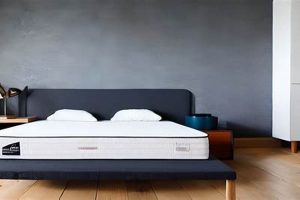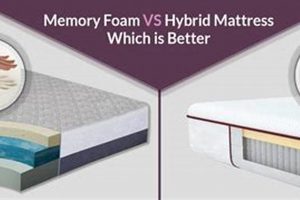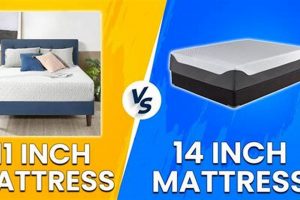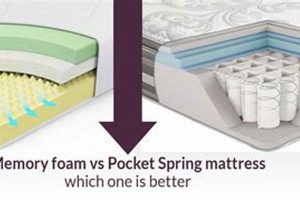The selection of temporary sleeping arrangements for visitors often necessitates a comparison between portable mattress solutions and inflatable beds. Factors such as support, convenience, and space constraints play crucial roles in determining the optimal choice. These options represent distinct approaches to providing a sleep surface for guests, each with inherent advantages and disadvantages.
The significance of providing comfortable and practical guest accommodations extends beyond mere hospitality. It contributes to positive social interactions and ensures that visitors experience restful sleep. Historically, the evolution of guest beds reflects changing societal norms and technological advancements in materials and manufacturing, from simple cots to increasingly sophisticated designs.
This analysis will delve into the specific attributes of portable mattresses and inflatable beds. The examination will encompass aspects like construction materials, portability, storage requirements, and perceived comfort levels. Ultimately, the goal is to provide a framework for evaluating these alternatives in order to make an informed decision based on individual needs and circumstances.
Tips for Evaluating Guest Bed Options
Selecting the most suitable sleeping arrangement for guests requires careful consideration of several key factors. These tips offer guidance in determining whether a portable mattress or an inflatable bed best meets specific needs.
Tip 1: Assess Storage Space. Portable mattresses, especially those constructed of denser foam, can require significant storage space when not in use. Inflatable beds, when deflated and packed, generally occupy less volume.
Tip 2: Evaluate Support Needs. Individuals with back pain or other orthopedic concerns may benefit from the firmer support often offered by portable mattresses. Inflatable beds can sometimes lack adequate spinal support, particularly if not fully inflated or if they develop leaks.
Tip 3: Consider Setup Time and Effort. Inflatable beds require inflation, which may involve manual or electric pumps. Portable mattresses are typically ready for use almost immediately, requiring only unfolding.
Tip 4: Analyze Durability and Longevity. Portable mattresses, depending on their construction, can offer greater long-term durability compared to inflatable beds, which are susceptible to punctures and air leaks.
Tip 5: Factor in Guest Preferences. If possible, inquire about guest preferences regarding mattress firmness and type. This can help ensure a more comfortable and restful experience.
Tip 6: Evaluate Intended Frequency of Use. For frequent guest visits, a more durable and supportive portable mattress may represent a better investment. For occasional use, an inflatable bed could be a more cost-effective solution.
Tip 7: Check the Dimensions. Ensure the selected option fits appropriately within the available space in the guest room. Consider both length and width to avoid overcrowding.
By carefully weighing these factors, a well-informed decision can be made regarding the most appropriate choice. Prioritizing guest comfort and convenience will contribute to a positive and welcoming experience.
Having explored these practical tips, the final section will provide a concise summary of the comparative analysis and offer concluding remarks.
1. Support
The level of support offered by a guest bed directly impacts sleep quality and musculoskeletal health. Within the context of selecting between a tri-fold mattress and an air mattress, support refers to the bed’s ability to maintain spinal alignment and distribute weight evenly, minimizing pressure points. Insufficient support can exacerbate existing back problems or contribute to discomfort and stiffness. A tri-fold mattress, typically constructed with foam or innerspring coils, generally provides a more consistent and stable support system compared to an air mattress. The uniform density of the mattress material helps maintain a level sleeping surface. In contrast, an air mattress relies on air pressure, which can be unevenly distributed and may fluctuate during the night, potentially compromising spinal alignment. For example, a guest with chronic lower back pain would likely experience greater relief and improved sleep quality on a supportive tri-fold mattress than on a less stable air mattress.
The type and density of materials used in a tri-fold mattress significantly affect its support capabilities. High-density foam or the inclusion of innerspring coils enhances the mattress’s ability to resist compression and maintain its shape under weight. Conversely, the support offered by an air mattress is contingent upon proper inflation and the integrity of its internal baffles. Over-inflation can create an overly firm and uncomfortable surface, while under-inflation can lead to sagging and inadequate support. Furthermore, air mattresses are prone to developing leaks, which can gradually reduce air pressure and diminish support throughout the night. Consider the scenario of a heavier guest; a tri-fold mattress designed for higher weight capacities will offer more consistent support, whereas an air mattress might require frequent adjustments to maintain adequate firmness.
Ultimately, the choice between a tri-fold mattress and an air mattress based on support depends on the specific needs and preferences of the guest. While air mattresses can offer adjustable firmness, their inherent instability and susceptibility to leaks make them less reliable for consistent support. Tri-fold mattresses, with their more uniform and durable construction, generally provide a superior level of support, particularly for individuals with orthopedic concerns or those who prioritize spinal alignment during sleep. The trade-off often involves storage space and portability, but the benefits of improved sleep quality and reduced musculoskeletal discomfort may outweigh these considerations. Therefore, when the goal is to provide optimal guest comfort and well-being, prioritizing support is paramount in determining which option is the superior choice.
2. Portability
Portability represents a critical factor in the decision-making process when evaluating temporary bedding solutions for guests. It encompasses the ease with which a sleeping arrangement can be moved, transported, and stored, impacting convenience and logistical feasibility.
- Weight and Dimensions
The weight and dimensions of both tri-fold mattresses and air mattresses significantly influence their portability. Tri-fold mattresses, particularly those made of dense foam, can be relatively heavy and bulky, making them cumbersome to move and transport, especially over long distances or up staircases. Air mattresses, in their deflated state, are considerably lighter and more compact, facilitating easier handling and transport. For instance, an individual living in an apartment building with limited elevator access might find an air mattress more manageable than a heavy tri-fold mattress.
- Storage Requirements
Storage space availability plays a crucial role in assessing portability. A tri-fold mattress, when folded, still occupies a substantial volume, potentially posing a challenge for individuals with limited storage capacity. An air mattress, once deflated, can be compressed into a significantly smaller package, requiring minimal storage space. The difference is considerable, a deflated air mattress can be stored in a closet or under a bed, whereas a folded tri-fold mattress may require dedicated storage space within a room.
- Ease of Setup and Takedown
While not directly related to physical movement, the ease of setting up and taking down a guest bed contributes to its overall portability in a practical sense. A tri-fold mattress requires minimal setup; it simply needs to be unfolded. An air mattress necessitates inflation, which can involve using a manual or electric pump, adding an extra step. Similarly, deflating an air mattress can be time-consuming, especially if it lacks a built-in deflation mechanism. Therefore, the speed and simplicity of deployment factor into the perception of portability.
- Transportability
Transportability extends beyond simple movement within a household; it encompasses the ability to take the guest bed to different locations. Air mattresses excel in this regard due to their compact size and light weight, making them suitable for travel or relocation. A tri-fold mattress, due to its bulk and weight, is less practical for transport outside the immediate household. For example, taking guest accommodations on a camping trip would be facilitated by an air mattress, while a tri-fold mattress would be highly impractical.
In summary, when prioritizing portability, air mattresses generally offer a distinct advantage over tri-fold mattresses. Their lighter weight, compact storage size, and ease of transport make them a more convenient option for individuals with limited space or those who require a guest bed that can be easily moved and stored. However, this advantage must be weighed against other factors, such as support and comfort, to determine the most suitable solution for a specific situation. The trade-off between portability and other attributes is a central consideration in the “tri-fold mattress vs air which one is better for guest” evaluation.
3. Storage
The availability of storage space is a crucial determinant in the selection between tri-fold mattresses and air mattresses for guest accommodations. The volume required for storing these items when not in use significantly impacts the practicality and convenience of each option.
- Volume Occupied
Tri-fold mattresses, even when folded, retain a substantial volume due to the inherent thickness and rigidity of the foam or innerspring materials. This can pose a significant challenge in smaller living spaces with limited closet or storage room. Air mattresses, conversely, deflate to a fraction of their inflated size, allowing for compact storage in drawers, shelves, or small storage containers. The discrepancy in storage volume represents a key differentiator in space-constrained environments. For instance, an apartment dweller may find the compact storage of an air mattress more appealing than the bulky profile of a tri-fold mattress.
- Storage Environment Requirements
Tri-fold mattresses generally require a dry and clean storage environment to prevent the growth of mold, mildew, or the accumulation of dust mites. Improper storage can compromise the mattress’s hygiene and longevity. Air mattresses, when properly deflated and stored in a protective bag or container, are less susceptible to environmental factors. This relative resilience can be advantageous in less controlled storage environments, such as garages or attics. Consider a damp basement: a tri-fold mattress stored in such a location would be at higher risk of damage compared to a deflated and sealed air mattress.
- Ease of Handling for Storage
The weight and bulk of tri-fold mattresses can make them difficult to maneuver and lift during storage. This presents a potential challenge for individuals with mobility limitations or those lacking assistance. Air mattresses, due to their lightweight and compact nature, are considerably easier to handle and store, requiring minimal physical exertion. An elderly homeowner, for example, would likely find storing an air mattress a simpler task than managing a heavy tri-fold mattress.
- Impact on Living Space
The storage solution chosen for a guest bed directly impacts the overall usability and aesthetic appeal of the living space. A bulky tri-fold mattress stored in plain sight can clutter a room and detract from its intended function. A neatly stored air mattress, on the other hand, minimizes disruption to the living environment. The choice between these options reflects a trade-off between readily available comfort and the preservation of open and uncluttered living areas.
In conclusion, storage considerations weigh heavily on the choice between tri-fold mattresses and air mattresses. The smaller storage footprint of air mattresses often makes them a more practical choice for individuals with limited space or those prioritizing ease of handling. However, the trade-off lies in the potential compromises in comfort and support compared to a tri-fold mattress. Therefore, a comprehensive assessment of storage constraints, guest needs, and personal preferences is essential for making an informed decision.
4. Durability
Durability, in the context of selecting between a tri-fold mattress and an air mattress for guest use, refers to the ability of each product to withstand repeated use and resist damage over an extended period. This characteristic directly impacts the long-term cost-effectiveness and overall satisfaction associated with the chosen sleeping solution.
- Material Integrity and Construction
The materials used in the construction of both tri-fold mattresses and air mattresses significantly influence their durability. Tri-fold mattresses typically employ foam, innerspring coils, and durable fabrics. High-density foam and reinforced stitching contribute to a longer lifespan. Air mattresses rely on PVC or similar polymers for their main structure. The thickness and quality of this material determine resistance to punctures and tears. For example, a tri-fold mattress with a high-density foam core will generally outlast an air mattress made from thin, low-grade PVC.
- Resistance to Wear and Tear
Guest beds are subject to varying levels of usage and potential mistreatment. Tri-fold mattresses exhibit greater resistance to everyday wear and tear, such as compression, stretching, and abrasion. Air mattresses are more vulnerable to damage from sharp objects, over-inflation, and seam separation. The implication is that a tri-fold mattress is better suited for households with children or pets, where accidental damage is more likely. Conversely, careful use and storage can prolong the lifespan of an air mattress.
- Longevity and Expected Lifespan
The expected lifespan of a guest bed directly affects its long-term value. A well-maintained tri-fold mattress can provide several years of reliable service, while an air mattress may require replacement more frequently due to leaks or material degradation. Frequent use and improper storage will shorten the lifespan of both types of beds, but air mattresses are inherently more susceptible to premature failure. For instance, a tri-fold mattress used only a few times a year could last for a decade, while an air mattress used with the same frequency might only last a few years.
- Repairability and Maintenance
The ease and cost of repairing a damaged guest bed influence its overall durability. Tri-fold mattresses are generally more difficult and expensive to repair. Tears in the fabric covering can be sewn, but internal damage to the foam or innerspring is often irreparable. Air mattresses, on the other hand, can often be patched to repair small punctures, extending their lifespan. However, significant seam failures or valve damage may render an air mattress unusable. The trade-off is that while initial repairs to an air mattress may be simple, the underlying material is more prone to failure.
Ultimately, the consideration of durability plays a crucial role in determining the most suitable guest bed. While air mattresses may offer advantages in portability and storage, their inherent susceptibility to damage often makes tri-fold mattresses a more reliable and cost-effective choice in the long term. The decision should be based on the frequency of use, the anticipated level of care, and the tolerance for potential repairs or replacements.
5. Cost
The economic aspect constitutes a significant factor in the decision between tri-fold mattresses and air mattresses for guest accommodations. The initial purchase price, potential maintenance expenses, and the expected lifespan contribute to the overall cost of ownership. Tri-fold mattresses typically represent a higher upfront investment compared to standard air mattresses. This reflects the more complex construction involving materials like foam, fabric, and sometimes innerspring coils. Air mattresses, with simpler designs primarily utilizing PVC or similar polymers, generally offer a lower initial price point. However, the total cost equation extends beyond the initial outlay, encompassing potential repair or replacement costs.
The long-term cost-effectiveness hinges on the durability and expected lifespan of each option. While air mattresses may present an attractive entry point due to their lower price, their susceptibility to punctures and leaks can lead to frequent repairs or replacements, increasing the overall expense over time. Tri-fold mattresses, with their more robust construction, tend to exhibit greater longevity, reducing the likelihood of premature replacement. Furthermore, specialized air mattresses with integrated pumps and enhanced features often command a price comparable to, or even exceeding, that of a basic tri-fold mattress. For instance, a household anticipating frequent guest visits may find the higher initial cost of a durable tri-fold mattress a more prudent investment than repeatedly replacing inexpensive air mattresses.
In summary, a comprehensive assessment of cost necessitates considering both the initial purchase price and the long-term ownership expenses. While air mattresses often offer a lower initial cost, the potential for frequent repairs or replacements can diminish their economic advantage. Tri-fold mattresses, despite a higher upfront investment, may prove more cost-effective over time due to their enhanced durability and extended lifespan. Therefore, the “tri-fold mattress vs air which one is better for guest” decision, from a financial perspective, requires a careful evaluation of usage frequency, expected lifespan, and potential maintenance costs.
6. Comfort
Comfort is a primary consideration when selecting a sleeping arrangement for guests. The perceived comfort level directly influences the quality of rest experienced by visitors and, consequently, their overall satisfaction. The selection of sleeping solutions inherently involves balancing comfort considerations with practical factors such as storage and cost.
- Surface Firmness and Support Distribution
Surface firmness profoundly impacts comfort, particularly for individuals with pre-existing musculoskeletal conditions. Tri-fold mattresses typically offer a more uniform and predictable firmness compared to air mattresses. Air mattresses, while adjustable, can exhibit uneven pressure distribution, leading to localized discomfort. An individual with chronic back pain, for example, may find the consistent support of a tri-fold mattress more beneficial than the potentially variable support of an air mattress. The ability of the sleeping surface to conform to the body’s contours while maintaining spinal alignment is critical for promoting restful sleep.
- Temperature Regulation
The ability of a sleeping surface to regulate temperature is a crucial component of comfort. Tri-fold mattresses constructed with breathable materials, such as open-cell foam, can facilitate air circulation and minimize heat retention. Air mattresses, particularly those made of PVC, tend to trap heat, potentially leading to discomfort, especially in warmer climates. The thermal properties of the materials used directly influence the sleeping experience, and individuals sensitive to temperature fluctuations may find one option more suitable than the other.
- Motion Transfer
Motion transfer, the degree to which movement on one part of the bed is felt on other parts, can significantly impact sleep quality, particularly for couples or light sleepers. Tri-fold mattresses generally exhibit lower motion transfer compared to air mattresses. The interconnected air chambers within an air mattress can amplify movement, potentially disturbing a sleeping partner. A tri-fold mattress, with its more solid construction, absorbs and isolates movement more effectively, minimizing disruptions.
- Surface Texture and Noise
The texture of the sleeping surface and any associated noise can influence perceived comfort. Tri-fold mattresses typically have a smooth fabric cover that minimizes friction and noise. Air mattresses, depending on the material and construction, can produce rustling or squeaking sounds during movement. The tactile and auditory experience contributes to the overall sense of comfort, and minimizing distractions is essential for promoting restful sleep.
In summary, comfort is a multifaceted consideration in the selection between tri-fold mattresses and air mattresses for guest use. Factors such as surface firmness, temperature regulation, motion transfer, and surface texture all contribute to the overall sleeping experience. While individual preferences vary, the consistent support and quiet operation of tri-fold mattresses may offer a more comfortable solution for many guests. The ultimate decision should be based on a careful assessment of guest needs, personal preferences, and the specific characteristics of each option.
7. Setup
The setup process constitutes a significant differentiating factor between tri-fold mattresses and air mattresses when considered as guest sleeping solutions. Setup refers to the time, effort, and resources required to prepare the bed for use. A tri-fold mattress typically involves a straightforward unfolding procedure. Once removed from storage, it requires minimal manipulation to be ready for use. Conversely, an air mattress necessitates inflation, which can involve utilizing a manual or electric pump. This process adds complexity and time to the setup, particularly if an electric pump is unavailable or malfunctions. Therefore, the immediacy of usability distinguishes tri-fold mattresses in scenarios where rapid deployment is essential.
The convenience of setup directly influences the user experience. For example, consider a situation where guests arrive late at night. The ease with which a tri-fold mattress can be deployed offers a distinct advantage, minimizing disruption and facilitating a quicker transition to sleep. Air mattresses, in contrast, require a more involved setup, potentially delaying the guest’s bedtime. The potential for pump noise during inflation can also be a concern, especially in shared living spaces. The practical implications extend to individuals with physical limitations; unfolding a tri-fold mattress may prove less strenuous than manually inflating an air mattress.
In conclusion, the setup process presents a key point of comparison in the evaluation. The simplicity and speed associated with tri-fold mattress setup offer a practical advantage over the more involved inflation process required for air mattresses. This factor should be carefully considered in relation to the anticipated frequency of use, the potential for spontaneous guest arrivals, and the physical capabilities of the user. The efficiency of setup contributes significantly to the overall convenience and desirability of each option as a guest sleeping solution.
Frequently Asked Questions
This section addresses common inquiries regarding the selection of temporary sleeping arrangements for guests, specifically focusing on tri-fold mattresses and air mattresses.
Question 1: What are the primary factors to consider when choosing between a tri-fold mattress and an air mattress for guests?
Key considerations include support, portability, storage space, durability, cost, comfort, and ease of setup. These factors influence the suitability of each option based on individual needs and circumstances.
Question 2: How does the level of support differ between a tri-fold mattress and an air mattress?
Tri-fold mattresses generally provide more consistent and stable support due to their uniform construction. Air mattresses rely on air pressure, which can be unevenly distributed and may fluctuate, potentially compromising spinal alignment.
Question 3: Which option is more portable and easier to store?
Air mattresses excel in portability and storage due to their deflated compact size and light weight. Tri-fold mattresses, even when folded, occupy significant volume and can be cumbersome to move and store.
Question 4: Which type of guest bed is more durable and longer-lasting?
Tri-fold mattresses tend to exhibit greater durability and longevity due to their robust construction and resistance to wear and tear. Air mattresses are more susceptible to punctures and material degradation.
Question 5: What are the typical cost implications of each option?
Air mattresses generally have a lower initial cost, but their potential for frequent repairs or replacements can increase the overall expense over time. Tri-fold mattresses, while having a higher upfront cost, may prove more cost-effective in the long run due to their increased durability.
Question 6: How does the comfort level compare between tri-fold mattresses and air mattresses?
Tri-fold mattresses often provide a more consistent and predictable comfort level due to their uniform surface firmness and support. Air mattresses can offer adjustable firmness, but may exhibit uneven pressure distribution and temperature regulation issues.
In summary, the optimal choice between a tri-fold mattress and an air mattress for guest accommodations depends on a careful assessment of individual priorities and constraints. There is no single “best” solution, as the ideal choice varies based on specific needs and preferences.
Having addressed these frequently asked questions, the final section will provide concluding thoughts.
Conclusion
The preceding analysis has explored the salient characteristics of tri-fold mattresses and air mattresses as prospective guest sleeping solutions. The evaluation encompassed support, portability, storage, durability, cost, comfort, and setup, revealing inherent strengths and weaknesses in each option. No singular solution emerges as universally superior. The suitability hinges upon a meticulous assessment of individual circumstances, prioritizing specific requirements. For scenarios demanding consistent support and long-term durability, a tri-fold mattress often presents a more judicious investment. Conversely, when portability and storage constraints are paramount, an air mattress offers a pragmatic alternative.
Ultimately, the decision to prioritize either option necessitates a careful weighting of these competing factors. The responsible host will conduct a thorough self-assessment to determine the optimal balance between guest comfort, spatial limitations, and budgetary considerations. Thoughtful deliberation will lead to the selection that best addresses the unique demands of the specific hosting environment, thereby ensuring a positive and restorative experience for welcomed guests.


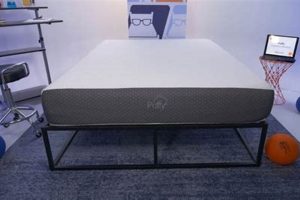
![Choosing Innerspring vs Memory Foam Mattress? [Guide] Organic & Natural Mattress Buyer’s Guide: Non-Toxic Sleep Solutions Choosing Innerspring vs Memory Foam Mattress? [Guide] | Organic & Natural Mattress Buyer’s Guide: Non-Toxic Sleep Solutions](https://mattressworldpa.com/wp-content/uploads/2025/07/th-1100-300x200.jpg)
